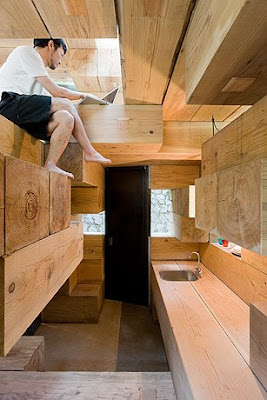The Portland Institute for Contemporary Arts (PICA) is a magnet for artists who take creative risks. The keystone of its annual programming, PICA's Time-Based Art Festival (TBA) draws international audiences and performers to Portland, Oregon, for pioneering performances that address culture, aesthetics, and ideas through theater, performance, dance, media, and music. The festival also serves a social function, forging discourse among artists and audiences.
To accommodate performances and social events, the venue needs for TBA 2004 included a 200-seat theater, in addition to a cabaret stage, bar, and café. A major PICA donor and Portland developer provided the raw space for these venues within a vacant warehouse, called "Machineworks." Portland's BOORA Architects then provided pro bono programming and design for the theater, creating it within the building's volume and reserving space for remaining performance and social needs. Guided by mock-ups to illustrate construction details, a team of volunteers then built the theater within a $10,000 construction budget.
The building's structural grid served as the driver for the diagram of the theater. As sufficient clear area for the stage could be found only within one of the building's structural bays, seating would be positioned in the bays of the grid surrounding the stage. The design team then positioned this whole assembly in front of existing offices lining one wall of the building, whose aesthetic qualities warranted concealment for their inconsistency with the qualitative goals for the festival environment. A small interstitial space between the rear of the theater and the offices preserved the functionality of the offices, capturing them for use as back-of-house support spaces. The efficient positioning of the theater within the warehouse reserved a large area of the building's remaining space for the cabaret, bar, and café. This open and uninterrupted space reflected the nature of the social activities taking place within the Machineworks venue while still achieving the desired degree of isolation for the theater.
To differentiate the theater volume from the surrounding volume of the warehouse, a scaffold ""media wall"" partially bisects the warehouse, defining the rear of the audience chamber and creating the envelope that encloses the theater. Illuminated from within, the media wall's interior and exterior are clad in the translucent materials pegboard and visqueen, respectively, giving the festival environment its signature quality: the glowing media wall offers the striking and ghostly experience of interacting with a volume of light contained within a gritty industrial shell. After passing a hanging entry marquee made of pegboard and suspended from the arm of a swinging crane, patrons entering the warehouse pass through a portal in this media wall, marked with a projecting canopy. The space within the media wall conceals technical equipment, transformers, and cabling, as well as an elevated control room that serves both the theater and the cabaret stage. Inside the theater, a scaffold substructure accommodates the three banks of long-tiered bench seating. Their assembly from five gallon plastic buckets, ½-inch MDF board, and recycled carpet tiles allowed all the materials to be returned to their original suppliers after the theater was dismantled.





www.boora.com
Diana Coelho





































